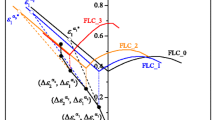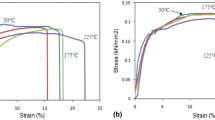Abstract
The Forming Limit Diagram (FLD) is an essential tool to assess sheet metal formability in sheet metal deep drawing. In FLDs/FLC (Forming Limit Curve) is representation of material formability limits at which material is not able to withstand higher deformation. In this work, different methodologies for FLC determination of mild steel DC01 are investigated. The Nakajima test is a well-known experiment for FLC determination but, however, contact conditions that can appear in the form of either friction or pressure may perturb the results. The former may cause the need for repetitions for different widths by altering the necking location, whereas the latter may be responsible for overestimation of the material formability. Another method for FLC determination without those effects is to use the cruciform specimen test under biaxial loading conditions. As the first step, Necking has to be induced at the center of cruciform specimen by thickness reduction or groove. Therefore, in this work, the cruciform geometry under biaxial loading is optimized using FEM through the comparative analysis. The goal of simulation was to induce the necking just in the thinner gauge, not adjacent zone. Thereupon, different loads on biaxial machine’s axes can provide different strain paths at the thinner gauge of the optimized specimen. After reviewing of various researches in connection with thickness reduction effect on sheet metal deformation, it was found that thickness reduction might not influence the material formability during uniaxial and plane strain tensions, but it was observed that there is gradual decrease of limit strains with decreasing the thickness for equi-biaxial tension.Manufacturing process like milling, cause small defects on material surface and local instability takes place at lower level of deformation. Besides, it was found that existence of through thickness normal stress leads to higher value of FLC. Deformation during Nakajima and cruciform experiments were captured by Digital Image Correlation (DIC) system. The execution and evaluation of those experiments are explained in detail and Time Dependent Method (TDM) was applied to detect the beginning time of instability. Experimental strain paths are compared with consideration of strain rates and, as it was expected, FLC from cruciform specimen is lower than Nakajima one, especially on the right hand side of FLD. The remarkable difference can be attributed to defects in the material and existence of through-thickness normal stress, which leads to overestimation of the material formability during Nakajima experiment.










Similar content being viewed by others
References
Keeler S, Backofen W (1964) Plastic instability and fracture in sheets stretched over rigid punches. ASM Trans Quart 56:25–48
Farahnak P, Prantl A, Dzugan J, Konopik P, Prochazka R (2017) Sheet necking prediction in forming limit diagrams with the anisotropy influence incorporation. IOP Conference Series: Materials Science and Engineering 179). Institute of Physics publishing. https://doi.org/10.1088/1757-899X/179/1/012023
DIN EN ISO 12004-2 (2009). Metallic materials- sheet and strip – determination of forming-limit curves – part 2: Determination of forming-limit curves in the laboratory
Nikhare C, Lester S (2014) Investigation of strain development and hole expansion ratio in mild steel and AA5083. International Deep Drawing Research Group (IDDRG), Paris
Chen X, Jiang H, Cui Z, Lian C, Lu C (2014) Hole expansion characteristics of ultra high strength steels. Procedia Engineering 81:718–723). Elsevier Ltd. https://doi.org/10.1016/j.proeng.2014.10.066
Nikhare C, Nolan J (2016) Hole expansion and strain evolution during biaxial testing. International Deep Drawing Research Group (IDDRG), Linz
Kuwabara T, Hashimoto K, Iizuka E, Yoon JW (2011) Effect of anisotropic yield functions on the accuracy of hole expansion simulations. J Mater Process Technol 211(3):475–481. https://doi.org/10.1016/j.jmatprotec.2010.10.025
Ram SM, Kang HT. Investigation of Hole Expansion Characteristics of DP 600 With Testing and Modeling. ASME. ASME International Mechanical Engineering Congress and Exposition, Volume 3: Design and Manufacturing, Parts A and B: 47–51. Doi: 10.1115/IMECE2010-39455
Ko YK, Lee JS, Huh H, Kim HK, Park SH (2007) Prediction of fracture in hub-hole expanding process using a new ductile fracture criterion. J Mater Process Technol 187–188:358–362. https://doi.org/10.1016/j.jmatprotec.2006.11.071
Narayanasamy R, Narayanan CS, Padmanabhan P, Venugopalan T (2010) Effect of mechanical and fractographic properties on hole expandability of various automobile steels during hole expansion test. Int J Adv Manuf Technol 47(1–4):365–380. https://doi.org/10.1007/s00170-009-2201-x
Naka T, Torikai G, Hino R, Yoshida F (2001) The effects of temperature and forming speed on the forming limit diagram for type 5083 aluminum-magnesium alloy sheet. Journal of Materials Processing Technology 113:648–653. https://doi.org/10.1016/S0924-0136(01)00650-1
Wu PD, Embury JD, Lloyd DJ, Huang Y, Neale KW (2009) Effects of superimposed hydrostatic pressure on sheet metal formability. Int J Plast 25(9):1711–1725. https://doi.org/10.1016/j.ijplas.2008.10.002
Padwal SB, Chaturvedi RC, Rao US (1992) Influence of superimposed hydrostatic tension on void growth in the neck of a metal sheet in biaxial stress fields. Part - I - Modelling. Journal of Materials Processing Tech 32(1–2):91–98. https://doi.org/10.1016/0924-0136(92)90166-P
Banabic D, Soare S (2008) On the effect of the normal pressure upon the forming limit strains, In 7th International Conference and Workshop on Numerical Simulation of 3D Sheet Metal Forming Processes, NUMISHEET 2008(pp. 199–204). Interlaken, Switzerland
Allwood JM, Shouler DR (2009) Generalised forming limit diagrams showing increased forming limits with non-planar stress states. Int J Plast 25(7):1207–1230. https://doi.org/10.1016/j.ijplas.2008.11.001
Assempour A, Nejadkhaki HK, Hashemi R (2010) Forming limit diagrams with the existence of through-thickness normal stress. Comput Mater Sci 48(3):504–508. https://doi.org/10.1016/j.commatsci.2010.02.013
Min J, Stoughton TB, Carsley JE, Lin J (2016) Compensation for process-dependent effects in the determination of localized necking limits. Int J Mech Sci 117:115–134. https://doi.org/10.1016/j.ijmecsci.2016.08.008
Basak S, Panda SK, Zhou YN (2015) Formability assessment of Prestrained automotive grade steel sheets using stress based and polar effective plastic strain-forming limit diagram. J Eng Mater Technol 137(4):041006. https://doi.org/10.1115/1.4030786
He J, Cedric Xia Z, Zeng D, Li S (2013) Forming limits of a sheet metal after continuous-bending-under-tension loading. J Eng Mater Technol 135(3):031009. https://doi.org/10.1115/1.4023676
Parsa MH, Ettehad M, Al Ahkami SN (2009) FLD determination of AL 3105/polypropylene/AL 3105 sandwich sheet using numerical calculation and experimental investigations. Int J Mater Form 2(SUPPL. 1):407–410. https://doi.org/10.1007/s12289-009-0502-0
Chow CL, Yang XJ, Chu E (2002) Prediction of forming limit diagram based on damage coupled kinematic-isotropic hardening model under nonproportional loading. J Eng Mater Technol 124(2):259. https://doi.org/10.1115/1.1431908
Nikhare CP, Vorisek E, Nolan JR, Roth JT (2017) Forming limit differences in hemispherical dome and biaxial test during Equibiaxial tension on cruciform. J Eng Mater Technol 139(4):041011. https://doi.org/10.1115/1.4037020
Hotz W, Merklein M, Kuppert A, Friebe H, Klein M (2013) Time dependent FLC determination comparison of different algorithms to detect the onset of unstable necking before fracture. Key Eng Mater 549:397–404. https://doi.org/10.4028/www.scientific.net/kem.549.397
Merklein, M., Kuppert, A., Mutze, S., & Geffert, A. (2010). New time dependent method for determination of forming limit curves applied to SZBS800. In Proceedings of the International Deep Drawing Research Group Conference (pp. 489–498). 10.3217/978-3-85125-108-1-054
Volk W, Hora P (2011) New algorithm for a robust user-independent evaluation of beginning instability for the experimental FLC determination. Int J Mater Form 4(3):339–346. https://doi.org/10.1007/s12289-010-1012-9
Farahnak P, Urbanek M, Džugan J (2017) Investigation study on determination of fracture strain and Fractuer forming limit curve using different experimental and numerical methods. Journal of Physics: Conference Series 896). Institute of Physics publishing. https://doi.org/10.1088/1742-6596/896/1/012082
Gorji M, Berisha B, Hora P, Barlat F (2016) Modeling of localization and fracture phenomena in strain and stress space for sheet metal forming. Int J Mater Form 9(5):573–584. https://doi.org/10.1007/s12289-015-1242-y
Graf A, Hosford W (1994) The influence of strain-path changes on forming limit diagrams of A1 6111 T4. Int J Mech Sci 36(10):897–910. https://doi.org/10.1016/0020-7403(94)90053-1
Song X, Leotoing L, Guines D, Ragneau E (2017) Identification of forming limits at fracture of DP600 sheet metal under linear and unloaded non-linear strain paths. Procedia Engineering 207:562–567). Elsevier Ltd. https://doi.org/10.1016/j.proeng.2017.10.1021
Farahnak P, Urbanek M, Rund M, Dzugan J (2018) Determination of forming limits of TWIP steel sheet using linear and nonlinear strain paths. IOP Conference Series: Materials Science and Engineering 461). Institute of Physics publishing. https://doi.org/10.1088/1757-899X/461/1/012019
Kuwabara T, Van Bael A, Iizuka E (2002) Measurement and analysis of yield locus and work hardening characteristics of steel sheets wtih different r-values. Acta Mater 50(14):3717–3729. https://doi.org/10.1016/S1359-6454(02)00184-2
Hou Y, Min J, Lin J, Carsley JE, Stoughton TB (2018) Cruciform specimen design for large plastic strain during biaxial tensile testing. Journal of Physics: Conference Series 1063). Institute of Physics publishing. https://doi.org/10.1088/1742-6596/1063/1/012160
Tasan CC, Hoefnagels JPM, Dekkers ECA, Geers MGD (2012) Multi-axial deformation setup for microscopic testing of sheet metal to fracture. Exp Mech 52(7):669–678. https://doi.org/10.1007/s11340-011-9532-x
Raghavan KS, Garrison WM (2010) An investigation of the relative effects of thickness and strength on the formability of steel sheet. Mater Sci Eng A 527(21–22):5565–5574. https://doi.org/10.1016/j.msea.2010.05.004
Hashemi R, Ghazanfari A, Abrinia K, Assempour A (2012) Forming limit diagrams of ground St14 steel sheets with different thicknesses. SAE International Journal of Materials and Manufacturing 5(1):60–64. https://doi.org/10.4271/2012-01-0018
Yuan WN, Wan M, Wu XD, Cheng C, Cai ZY, Ma BL (2018) A numerical MK approach for predicting the forming limits of material AA5754-O. Int J Adv Manuf Technol 98(1–4):811–825
Zidane I, Guines D, Léotoing L, Ragneau E (2010) Development of an in-plane biaxial test for forming limit curve (FLC) characterization of metallic sheets. Meas Sci Technol 21(5):055701. https://doi.org/10.1088/0957-0233/21/5/055701
Song X, Leotoing L, Guines D, Ragneau E (2017) Characterization of forming limits at fracture with an optimized cruciform specimen: application to DP600 steel sheets. Int J Mech Sci 126:35–43. https://doi.org/10.1016/j.ijmecsci.2017.03.023
Karthik V, Comstock RJ, Hershberger DL, Wagoner RH (2002) Variability of sheet formability and formability testing. J Mater Process Technol 121(2–3):350–362. https://doi.org/10.1016/S0924-0136(01)01219-5
Narayanasamy R, Ravi Chandran M, Parthasarathi NL (2008) Effect of annealing on formability of aluminium grade 19000. Mater Des 29(8):1633–1653. https://doi.org/10.1016/j.matdes.2006.12.019
Rees DWA (2001) Factors influencing the FLD of automotive sheet metal. Journal of Materials Processing Technology 118:1–8. https://doi.org/10.1016/S0924-0136(01)01030-5
Zadpoor AA, Sinke J, Benedictus R (2009) The effects of thickness on the formability of 2000 and 7000 series high strength aluminum alloys. Key Eng Mater 410–411:459–466. https://doi.org/10.4028/www.scientific.net/kem.410-411.459
Urbánek M, Farahnak P, Rund M, Džugan J (2018) Sheet thickness reduction influence on fracture strain determination. Journal of Physics: Conference Series 1063). Institute of Physics Publishing. https://doi.org/10.1088/1742-6596/1063/1/012168
CEN. (2016). EN ISO 6892-1 Metallic materials — Tensile testing Part 1: Method of test at room temperature. International Organization for Standardization (p. 79). 10.3403/30268532
Prantl A, Urbánek M, Prochazka R, Džugan J (2016) Evaluation of influence of strain path on FLD diagram. International Deep Drawing Research Group (IDDRG), Linz
Farahnak P, Azinpour E, Belinha J, Cesar de Sá JMA (2017) The numerical non-linear analysis of elastoplastic materials using the radial point interpolation method. Material Modelling: Applications, Challenges and Research
Acknowledgements
This paper is a result of the project Development of West-Bohemian Centre of Materials and Metallurgy No.: LO1412, financed by the MEYS of the Czech Republic and project methods development for formability assessment of thin sheets considering anisotropy and non-linear loading path No.: TF02000072, financed by Technology Agency of the Czech Republic.
Funding
This study was funded by MEYS of the Czech Republic (NO. LO1412) as well as Technology Agency of the Czech Republic (No. TF02000072).
Author information
Authors and Affiliations
Corresponding author
Ethics declarations
Conflict of interest
All authors have received research grants from COMTES FHT, a private research company in Czech Republic.
Additional information
Publisher’s note
Springer Nature remains neutral with regard to jurisdictional claims in published maps and institutional affiliations.
Rights and permissions
About this article
Cite this article
Farahnak, P., Urbánek, M., Konopík, P. et al. Influence of thickness reduction on forming limits of mild steel DC01. Int J Mater Form 13, 371–381 (2020). https://doi.org/10.1007/s12289-019-01513-3
Received:
Accepted:
Published:
Issue Date:
DOI: https://doi.org/10.1007/s12289-019-01513-3




